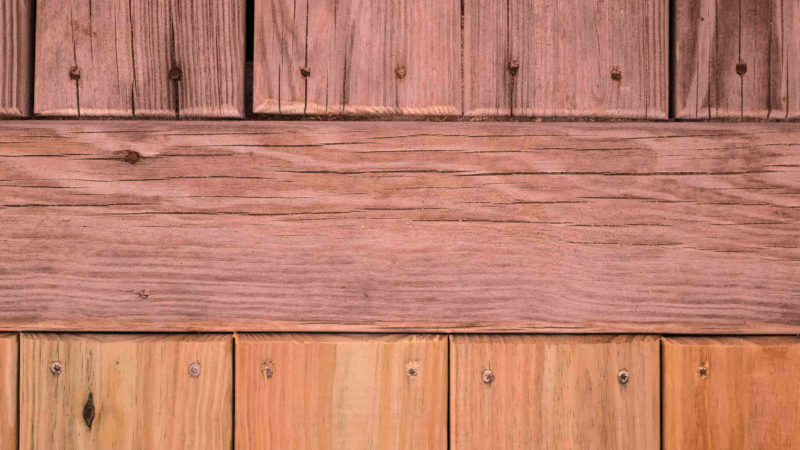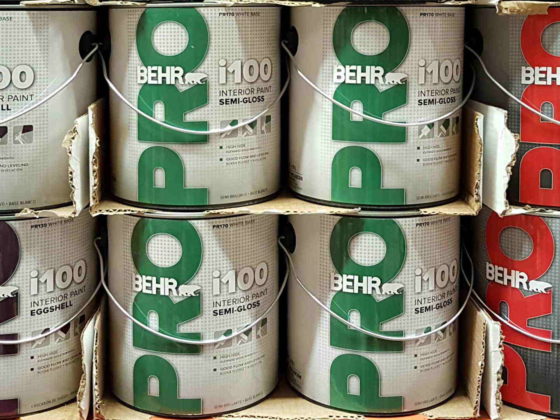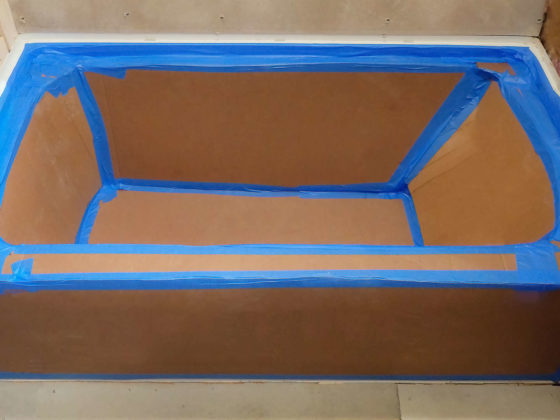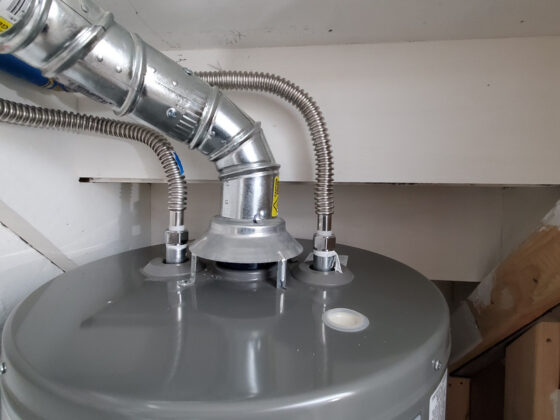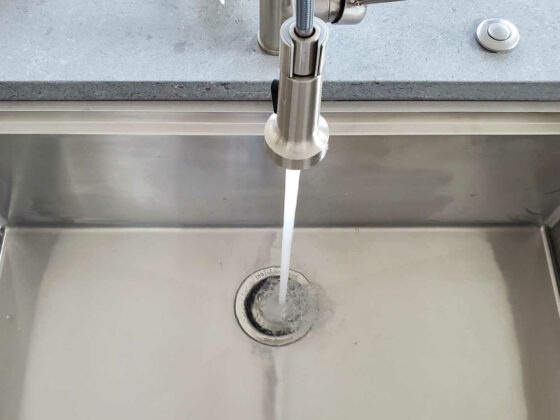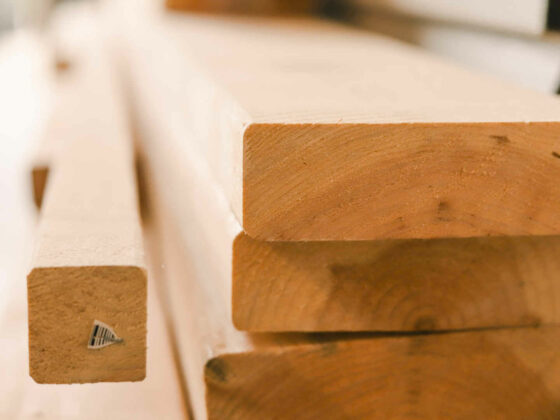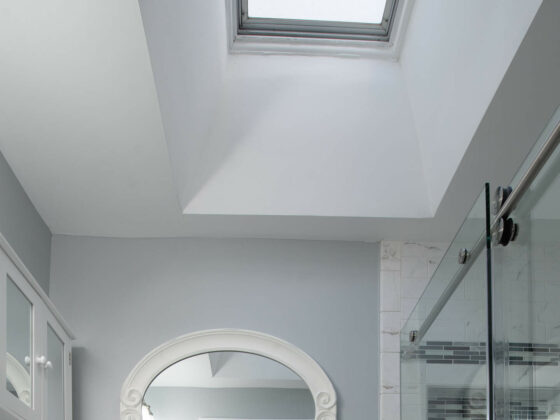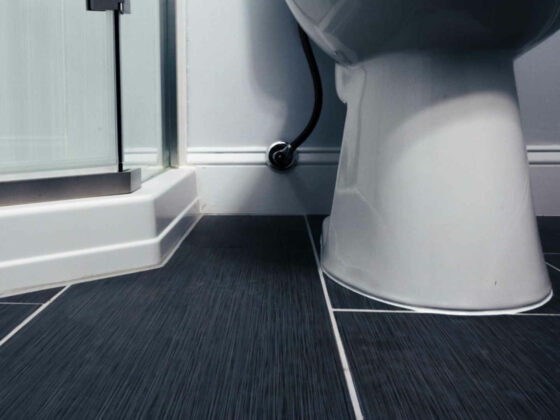Pressure treated lumber or wood is one of the most used building materials in the world and in this article we are going to cover all of the questions that you may have about pressure treated lumber.
What is pressure treated wood? Pressure treated wood is a type of wood, impregnated with chemicals that prevent its rotting. Such wood can be exposed for decades in various applications susceptible to water and moisture. Green wood is often used in the construction of decks, and in applications where the wood is in contact with concrete or soil.
Pressure treated wood is generally used for surfaces that will have contact with outside conditions such as moisture from rain, snow, and mud. As well as cold temperatures and also insects that may try to eat away at wood however due to it being treated it is no longer an attractive form of nutrition for them.
How to recognize pressure treated wood?
The majority of contemporary pressure treated wood comes with a so-called ‘end tag’ which is in most cases either a little sticker at the end of the wood or it is printed on which has information about the company that has manufactured this material, the warranty, any regulatory bodies that they may be part of and also very important what type of wood this is allowing you to easily recognize if it is the type of wood that you are looking for.
If you happen to be reusing material then you may not be able to find the end tag, therefore you will have to look out for a few pointers such as if your wood has some kind of unnatural green tint that signifies that it has been sprayed with something. Generally, all pieces of wood that have been cut into different parts that have joints to help them be assembled much more easily are pressure treated as part of the manufacturing process.
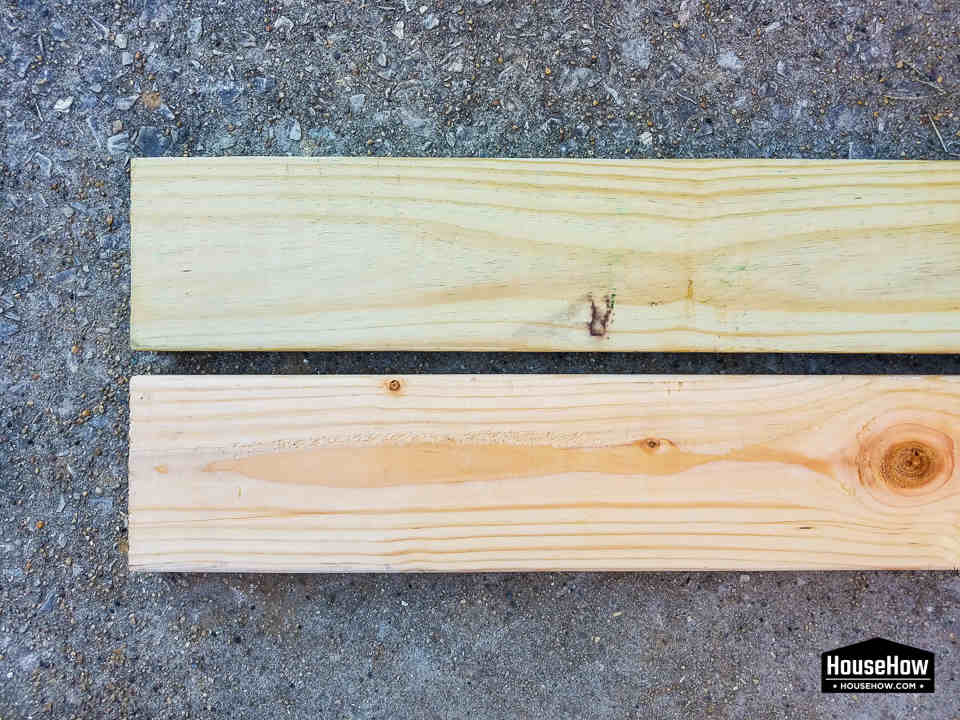
Preservatives used with pressure treated lumber
As pressure treated lumber is going to be used in buildings you need to make sure that there is nothing toxic being sprayed on the materials that can harm people that get in contact with the material. Up to 2003 in the United States, it was very popular for a substance called ‘Chromate Copper Arsenate‘ to be used which could be very toxic in large amounts.
However, you do not have to worry as all modern preservatives used in the preservation of wood are all tested by governmental regulatory bodies and health agencies. There are hundreds of different preservatives available for the different uses of pressure-treated wood. Common preservatives used include ‘Copper Azole‘ which is great for wood that will be under heavy exposure of dirt as well as ‘Waterborne Copper Naphthenate‘ which as you may have guessed helps maintain the wood in damp conditions.
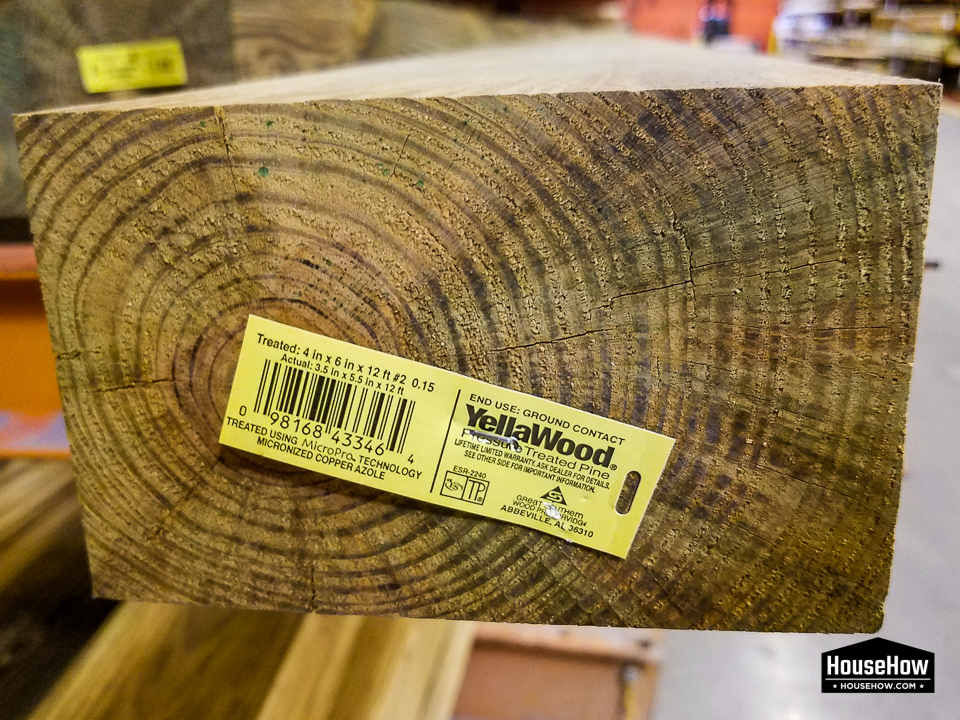
Application
How do I know which product to use in which application?
The type of pressure treated wood that you get will all depend on where it is going to be used and the conditions it is going to be put under. For example, if you are thinking of using it in the outdoors where it will be in contact with dirt, moisture, and insects such as termites it will be heavily recommended to get a piece of wood for those type of conditions.
What does “ground contact” mean?
‘Ground contact’ is a term used to specify if a piece of lumber is able to be placed on top of the concrete, ground or in the ground without any problems such as the wood starting to decay from the natural conditions, breaking or being eaten by insects.
Whether a piece of wood is suitable for ground contact does not just depend on whether it has been treated with the right preservatives but it also depends on the type of wood with some pieces of wood being better at not absorbing water than others which is very important as in most places the ground can be very damp.
Are there different grades of pressure treated lumber?
Yes, there are different grades of pressure treated lumber, after all with so many varieties there needs to be a system in place that allows for people to make up their mind and be able to quickly and easily know what they are buying without any prior experience on the topic.
The way the grading system works is by specifying the number of preservatives used as part of the treatment as well as the retention level as not all wood is able to absorb as many preservatives as others and generally the more preservatives they can absorb the higher the quality as the wood will take longer to decay as well as being less attractive to insects as a food source.
Can pressure treated wood be in contact with regular wood?
Pressure treated wood can be in contact with regular wood in the majority of circumstances as even if a piece of green lumber is rotting away this is the condition is not going to spread over to the treated lumber due to the preservatives that it has been treated with.
However, what can cause problems if, for example, you are using regular wood to build a structure or part of a structure that has contact with the ground and then you are joining it together with a piece of treated lumber that is also not made for ground contact. This means that if the conditions are really severe the conditions affecting the regular green lumber can quickly spread to your treated wood that although has been treated is not made for the conditions associated with ground contact.
Apart from that there are no problems for treated wood to be in contact with regular wood as after all a lot of furniture is made using untreated wood and there are never any problems.
Why not to use pressure treated wood indoors?
You can use pressure treated wood indoors if you wish to do so however there is no actual need as treated lumber is generally used for the outside where it will be subjected to various conditions that regular wood will not be able to cope in.
Due to the very reason that treated wood is made to be used outside as well as for structural purposes, there is no attention whatsoever paid to how it looks aesthetically. So if you decide to use treated lumber your home may end up looking a bit like a warehouse and not very homely or appealing to the eye.
Can pressure treated wood be used in gardens?
Yes, pressure-treated wood can be used in gardens for making garden beds, making structures to create shade and shield you from the sun and rain during the various seasons all year round.
However, it may not look very natural for some placements, with a big risk that the treated lumber will not be able to blend into your garden and instead of looking out of place like someone has forgotten to remove it from there which is due to the way that treated lumber is cut into neat thin planks. If you are looking for wood that will blend into your garden and make it look more natural then it is recommended to either go for untreated wood like a log.
Alternatively, if you are going to be building structures in your garden as we mentioned above such as the sun and rain shelter then it is recommended to go with treated wood which is made for being used in construction and withstanding all the consequences of being outside.
What fasteners are recommended for pressure treated lumber?
It is recommended to use fasteners that are also not going to be affected by outside conditions such as moisture and cold temperatures. This is why you should make sure that the fasteners that you are using are not going to rust when exposed to moisture which is very important because if your fasteners start to break down there is a very big chance that the whole structure will come falling down.
Another thing you should take into account when using screws for treated lumber is that they do not get affected by the chemicals used in the actual lumber. Therefore it is recommended that you get non-corrosive fasteners which are guaranteed not to break down when exposed to the majority of chemicals out there.
What nails are recommended for pressure treated lumber?
Nails like fasteners need to be specially manufactured in order not to corrode when exposed to the chemicals that it will be exposed to when inserted inside the treated lumber. Therefore it is recommended to pick hot dipped galvanized wood screws which are resistant to all the preservatives found in treated wood.
To prevent your nails from rusting you need to make sure that they are made of high-quality stainless steel, aluminum or are painted which will help prevent or at best greatly slow down the rusting process allowing you decades to enjoy the construction work. They may be a bit more expensive but they are definitely worth every penny as you do not want to be cutting corners and then ending up rebuilding the whole thing all over again after a few years when the whole thing has come down.
Durability
Why does some treated lumber warp?
The effect of ‘warping’ in wood is commonly found in both untreated and treated wood as wood is a naturally occurring material that grows organically so it will not in every case grow perfectly straight leading to structures and gap on the inside that can swell up if exposed to moisture or alternatively it can start to decay leading to the piece of wood bending in a certain area or snapping altogether.
Warping in any type of wood related material cannot be 100% prevented but can be greatly reduced as long by storing it correctly through all stages of its life from when it has just been freshly cut and is just a piece of green wood to when it is being manufactured and treated to finally when it is being transported and stored before finally being used in the construction project. It needs to be stored in a way where it will not be under any pressure from other pieces of wood and it will also not be exposed to any moisture or temperatures that it is not able to cope with.
Can termites get into pressure treated wood?
If the pressure treated wood is dealt with properly during its manufacturing, various periods of storage and also is used correctly in construction then you should have no problems with termites getting inside and starting to devour and gradually break down your building material.
A big mistake that a lot of builders and homeowners do is that they place treated wood in contact with soil which forces the soil to get into the wood’s natural cracks and gaps which in turn creates a natural barrier between the preservatives treated into the wood to stop the termites getting in and eating it and ultimately the termites themselves.
You also need to keep in mind that no piece of wood no matter how much and with what it has been treated with is resistant forever. If your pressure-treated wood is really old or has been subject to excessive amounts of moisture then it will start to wear down and ultimately start to decay much earlier and thus being vulnerable to termites.
Will pressure treated wood rot?
Yes, pressure-treated lumber will sooner or later end up starting to rot, as mentioned above, no matter what tree this wood is from and what preservatives it has been treated with. Sooner or later it will start to rot and become less resistant to the environmental conditions it has been made to resist against.
This is why you need to make sure to be caring for your treated lumber properly by making sure it is not placed on or in environments that it is not originally made to be placed in such as in soil. Also, it is recommended to occasionally clean it by for example shoveling or sweeping off the dirt from it as dirt and mud itself absorbs water which can significantly speed up the wearing down of the building materials leading it to start rotting sooner. Furthermore, you can apply various treatments to it such as ‘sealing’ in order to help enhance the resistant abilities of the wood and allow it to stay healthy for a few extra years.
Finally, you need to keep in mind that you will eventually have to replace it ones it gets too old no matter how well you have looked after it.
Painting
How long do you have to wait to paint treated wood?
The general average wait is 3 to 4 months in order to wait for all the preservatives and chemicals used in the treating of the wood to all properly dry. The wood will seem dry however to the naked eye and also touch however on the inside it will still contain some chemicals that have not yet been fully absorbed or has not yet evaporated. If it is sealed too soon it will lead to complications as all the moisture trapped inside has nowhere to go.
Furthermore you need to wait for the right moment to paint it, generally, during Autumn, Winter and the Spring seasons when there is a high chance that it may be raining or snowing where you are living then you should not paint your treated wood as it needs to be fully dry which leaves you with only a few time frames when it is possible to paint it.
Can I paint treated wood right away?
No, it is not recommended to paint treated wood straight away as it will only lead to further complications that will cost you a lot of time and money to fix. If you are buying kiln-dried treated wood then you will have to wait a much smaller amount of time before you can safely begin the process of painting.
As stated above for some people depending on where there live there may be just a few months in the year where they can paint their structures made from treated wood. If that is a big problem then it may be a good idea to put some kind of cover made from plastic on top or over your treated wood to allow it to dry without it being constantly re-exposed from moisture from rain or snow.
Furthermore, another important step is to make sure that the wood is clean from any dirt, grime, and dust in order prevent it being covered by the paint allowing with moisture the dirt may be holding causing future problems.
What happens if you paint treated wood too soon?
If you paint the treated wood too soon then the paint will not be able to be applied the way it should as all paints use oils in order to get a hold onto the surface that is being painted. If the treated wood’s surface is wet then the oils in the paint will be diluted by the water inside the treated wood, in turn, reducing the effectiveness of the paint which will result in you have to spend more money on buying extra paint or even the paint peeling off after a certain period of time.
With treated wood especially there will be a lot of water inside that needs months to fully evaporate, if you decide to paint the wood too soon then what will happen is that the treated lumber will start to crack on the surface and even warp or bend if there is a lot of water inside the piece of wood.
Do I need to seal pressure treated wood?
No, there is no need to seal pressure treated wood it has open cuts where you have cut it in order to make it fit into place or for whatever other reason that you may have. Generally, when a piece of wood has been treated it will not need to be sealed as it will already contain chemicals that will allow it not to be at danger of decaying when exposed to moisture or water.
However, sealing pressure treated wood will undoubtedly prolong its life by making it more resistant to the effects of moisture in particular. It will also provide a protective layer that will reduce the risk of your wood getting scratched and dented which is not just bad appearance wide but it can also impact the lifetime of your treated lumber as this dent can expose it to moisture and also insects.
Another reason why sealing is important is that although not every plank of treated wood is going to get cut in smaller pieces, the however majority will be pierced using fasteners or nails which will again expose it to the effects of its surrounding environment leading potentially to decay.
What causes splitting and checking?
Splitting and checking occur as the wood dries, it is estimated that some species of wood’s body weight is up to half made out of water. Although this is a natural process and it is inevitable, mismanagement can increase the amount of splitting and checking that occurs as well as the average size of the indentations.
It is very important to allow the wood to dry naturally because if you dry to speed up the process by turning on a heater or blow dryer to try and get the water to evaporate faster this will cause massive cases of splitting and cracking which happen due to massive amounts of water leaving the lumber. Furthermore, if you decide to coat and paint a plank of treated lumber too soon, in turn, trapping all the water inside which then has no exits to evaporate from causing it to warp the wood.
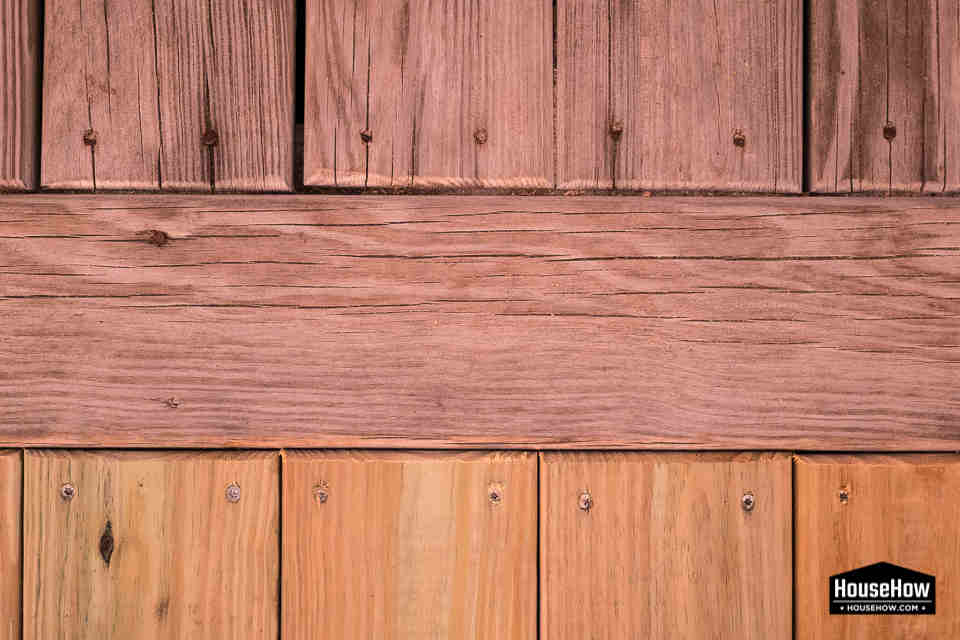
Safety
Is pressure treated wood safe?
There used to be safety issues and concerns with pressure treated wood, however, since 2003 the whole industry has been tightly regulated by governmental bodies and health agencies who work to prevent that no treated wood is preserved using chemicals that are toxic or can become toxic from chemical reactions.
Treated lumber is used in tens of millions of properties in the United States and hundreds of millions all around the world so you have no reason to be worried as long as you are buying your treated wood from a reputable business that is a member of the relevant regulatory standard agencies.
However, it can become dangerous if not used or dealt with in the right way, for example, it should not be burned to avoid any chemicals going into the air and also it should not be used as a surface for preparing food to avoid any chemicals getting into the food. Although it would not kill you if it gets on your food it can definitely make you very ill.
Is it safe to use pressure treated wood around plants and animals?
Yes, it is definitely safe to use pressure treated wood around both plants and animals as long as it comes with the EPP certification which means that the product has no environmental impact on its surroundings.
There is nothing to worry about as lumber that is pressure treated is created specifically to be used outside so there will not be any problems from the preservatives that the wood may contain killing any plants and flowers in your back garden.
Moreover, all the planks of treated wood are created to be safe for humans so if they are safe for humans to be around then there is no reason why they will not be for your animals.
Is pressure treated wood dust toxic?
No, pressure treated wood dust is not toxic, everything is monitored by government-owned agencies and the products will not be allowed to be sold to the public if there was such as danger. After all, treated wood is a building material that will in most cases need to be cut, drilled and altered in other ways in order to be effectively used in the construction project which results in dust being created from the plank of treated lumber.
Although it is not toxic, it is still not recommended to consume it by inhaling the dust, eating it or smoking it as it is still small shavings of a piece of wood that can cause terrible damage to your organs if consumed in large amounts even though it may not be toxic. This is why when cutting and generally working with wood you should wear a respiratory mask that allows you to breathe without taking in harmful particles in your body system.
You should also make sure to clean up any leftover wood dust after you have done working to avoid it flying around your garden and inside your home.
Can you get sick from pressure treated wood?
Although it is not toxic enough to kill you, you can definitely get ill from interacting with pressure treated wood in various ways. The first example will be not to burn treated wood in order to get rid of it or especially not for cooking barbecues as the preservatives in the wood will very easily get on your food and potentially make the individuals consuming the food very ill. Further related to food safety, as stated further above in this section, you should not use treated wood as a food preparation surface and also you should not use it to create surfaces that you will be eating in such as dining tables and picnics tables.
Also do not use treated lumber to make feeding troughs and watering trays for animals as they can consume the various chemicals found in the wood which can then be stored in their meat, milk, and eggs that you will then consume yourself.
How should I dispose of scraps?
When disposing of treated lumber it is recommended to just throw it away if possible in whole parts without cutting it up as that will create a lot of sawdust everywhere that will also need to be cleaned up. To avoid cutting it you can try snapping planks into smaller pieces if you need to make them fit into a van or skip as this will greatly reduce the amount of sawdust created.
You also must never burn lumber that has been treated in order to dispose of it as this will put all the chemical preservatives into the air that you, your family and neighbors will breathe in.
Additionally treated wood cannot be used to make compost or fertilizer for plants as it will contain the chemicals used to preserve the wood that can potentially make people fall ill if you are growing food.
Regular wood and pressure treated wood prices
| Dimensions | Dried Hem Fir Stud Prices | Pressure Treated Lumber Prices |
| 2in. x 4in. x 96in. | $3.05 | $3.77 |
| 2in. x 6in. x 96in. | $5.77 | $9.17 |
| 2in. x 8in. x 96in. | $10.11 | $12.57 |
| 2in. x 10in. x 96in. | $13.32 | $18.77 |
| 2in. x 12in. x 96in. | $16.77 | $20.56 |
*Prices from September 12, 2020
Related community topics
If you have any other questions that are not answered in this article, you can ask them on our Home Improvement Community Forum by clicking on this link.

